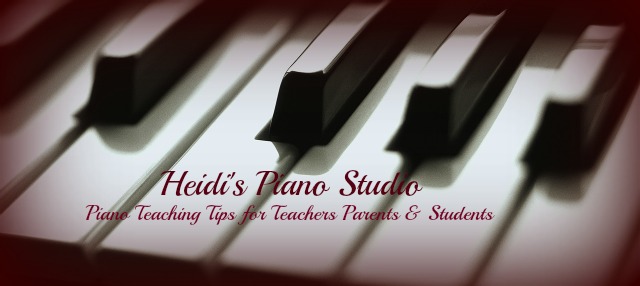

Search This Blog
- Piano Lesson Book Plans
- Piano Online Activities
- Piano Game Resource List
- Spicing Up Piano Lessons
- Music Lessons and Camps
- Free Piano Teaching Printables
Friday, February 16, 2018
Using piano safari rote pieces to teach composing in piano lessons.

- Compose a song sandwich for a different animal following the form
- Sound Effect Intro + Melody + Sound Effect Ending
- Be sure to choose a scale and pitch that represent the animal.
- Would a bird sound high or low? Is your hippo happy or sad (major or minor)?
- Compose a song that alternates between repeated notes and step/skip patterns.
- Imagine a conversation between two different animals and switch back and forth between hands.
- Compose a song that includes at least 3 sequences (musical patterns repeated started on a different note) + an ending.
- Compose a song on the black keys that includes the same rhythm patterns as Kristabel Kangaroo but has a different melody.
- Compose a song with 3 note slurs but transpose to Major and/or Invert the Melody patterns
- Change some of the rhythms from short notes (quarter notes) to long notes (half notes) and/or change some from long notes to short notes.
- Is your bird soaring in the sky, looking for food, or racing to hide from an enemy?
- Follow the chord patterns in the bass, but change the melody using different notes within the C, F and G chords.
- Change up the rhythm pattern in the bass to create a variation of Monkey Blues.
No comments:
Post a comment, contributors.
- Heidi's Piano Notes
Popular Posts

- Free Music "Glorious" sung by David Archuleta

My Blog List
Blog topics.
- Activities (1)
- Arranging (8)
- Baroque (1)
- Chords (70)
- composing (62)
- Ear Training (63)
- Free Resources (58)
- Games (105)
- Group Lessons (64)
- Holidays and Seasonal (24)
- Improvisation (71)
- Improvisation Scales (4)
- Improvising (3)
- inspiration (37)
- Intervals (1)
- Key Signatures (1)
- Lesson Plans (25)
- Links (102)
- Movement (36)
- Music History (21)
- Musical Forms (1)
- Notereading (71)
- Pedaling (3)
- Performing (1)
- Piano Adventures (22)
- Piano Adventures (175)
- Piano Adventures 2A (2)
- Piano Camp (3)
- Piano Festival (9)
- Piano Lab (3)
- Piano Lab Activities (367)
- Piano Lab Activities Improvisation (1)
- Piano Lab Assignments (10)
- Piano Practice (7)
- Piano Pronto (67)
- Piano Pronto Key Signatures (1)
- Piano Pronto2 (1)
- Piano Repertoire Videos (3)
- Practice Incentives (20)
- Preschool Music (3)
- Reviews (8)
- Rhythm (99)
- Rote Piano Teaching (4)
- Scales (27)
- Seasonal (1)
- Studio Organization (26)
- Teaching (178)
- Technique (55)
- Theory (96)
- Transposition (2)
- Workshop Notes (12)
Subscribe To
Blog Archive
- ► April (10)
- ► March (12)
- ► January (3)
- ► December (4)
- ► November (4)
- ► October (15)
- ► September (50)
- ► August (221)
- ► July (49)
- ► June (5)
- ► April (1)
- ► March (1)
- ► February (1)
- ► November (2)
- ► October (1)
- ► June (2)
- ► December (2)
- ► November (1)
- ► September (3)
- ► May (1)
- ► April (3)
- ► March (4)
- ► February (5)
- ► January (10)
- ► December (1)
- ► October (13)
- ► August (1)
- ► April (11)
- ► March (6)
- ► February (4)
- ► January (9)
- ► December (3)
- ► October (2)
- ► July (2)
- ► June (4)
- ► April (7)
- ► January (1)
- ► November (9)
- ► October (3)
- ► September (1)
- ► August (2)
- ► July (1)
- ► May (2)
- ► April (2)
- Using Piano Safari Rote Pieces to Teach Composing ...
- Valentines Composing Piano Group Lessons
- ► January (5)
- ► December (6)
- ► November (3)
- ► October (6)
- ► September (7)
- ► August (3)
- ► June (1)
- ► May (5)
- ► March (2)
- ► September (2)
- ► October (5)
- ► May (3)
- ► January (2)
- ► September (4)
- ► May (6)
- ► February (3)
- ► April (6)
- ► August (5)
- ► July (6)
- ► April (5)
- ► February (2)
- ► January (7)
- ► October (4)
- ► July (3)
- ► May (10)
- ► January (6)
- ► December (7)
- ► October (8)
- ► September (16)
- ► August (7)
Heidi Neal- Piano Instructor - As an Amazon Associate I earn from qualifying purchases.

African Safari
African Safari is one of the most popular pieces in the Rote and Reading™ series.
This comes with a studio license and is a fantastic value as this can be used for as many students as you directly teach
- Description
- Reviews (8)
- Level: Elementary
- Pages: 4 pages; 2 of music, cover included!
- Style: Big and bold
- Series: Rote and Reading®
- Format: PDF instant download
African Safari is definitely one of our most popular Rote and Reading® solos for mid-elementary piano students. This piece is designed to be taught by rote with the score helping to give visual cues to help piano students remember what is next. The left hand plays a low A during the right hand motive, producing a deep and satisfying sound that sounds harder than it is.
What level is African Safari?
African Safari is mid-elementary level. The piece can easily be taught by rote while using the score as visual cues to what is next and moving high and love. The smallest note value in African Safari is the eighth note, but students do not need to have been introduced to the eighth note prior to learning this piece. The rhythm pattern can easily be taught by rote.
More pieces in the African Rote and Reading series
This piece is one of three pieces in the African Adventure set of Rote and Reading® pieces. Each of these pieces is an exciting piano adventure for the mid elementary piano student.
8 reviews for African Safari
Melody Dean – August 4, 2017
My 4th grade student played this at the end of our recital and left everyone on a high note! As a matter of fact, 2 of my other students were asking to play the piece after the recital!
Irma Khouw – August 4, 2017
African Safari is a HUGE hit!
Elizabeth – September 3, 2017
A fun piece to play with tons of artistic expression and storytelling opportunities for a beginning student. Great for rote teaching and definitely recital worthy!
Linda Wilson – September 13, 2017
My students LOVE this piece!!!
Nicole – September 29, 2017
I purchased the African Adventures series specifically with a 14 year old student in mind. She has dyspraxia and has had numerous teachers give up on her over the last few years as she couldn’t play two hands together or read music fluently. This morning, we experimented together and we tried learning African Safari by rote. This is new to me so I had no idea if it would work for a dyspraxic teenager. I’m overjoyed to say that in 30 minutes she was playing the first half, both hands, from memory! Remarkable! A few tears of joy have been shed by student, parent and teacher this morning! Thank you Wendy for producing a series of pieces that may just change the whole learning experience for this young girl. I said I wouldn’t give up until I found a way to help her learn piano and you’ve made it possible. We are all indebted to you for this moment of excitement and achievement!
Rachel Wilke – October 10, 2017
African Safari wins again! I have two more new teen students who have just had 3 lessons and wanted something that sounded impressive to play even though they can’t read or play much yet. I gave them a choice of which one of your songs they would like and both chose African Safari. African Safari is the all time favorite for most of my students. Almost every kids asks if you would write pieces more like that. They love the catchy rhythm and getting to use the entire piano.
Mandy – November 2, 2017
I have lost count of the number of students I have given this piece to – they all LOVE it!! It saved one student I thought I would lose, as she was really struggling with note reading and her best friend (whom I also teach) was breezing along, which made it all the more difficult. I gave her African Safari – this was the turning point for her, as she was able to learn this piece by rote very quickly and felt a huge sense of accomplishment. She now has a renewed determination to succeed thanks to this wonderful piece and is also patiently persisting with reading, knowing that there are more of Wendy’s fabulous pieces waiting for her to learn quickly and easily!
Skye McManus – March 9, 2021
I think I taught African safari to almost all of my students and they all loved it! It was so easy to teach over zoom!
Your email address will not be published. Required fields are marked *
Your review *
Name *
Email *
You may also like…

Barnyard Fun Bundle

Canadian Adventure Bundle: Vancouver Island Sunset + I Want Some Water + Lumbering King
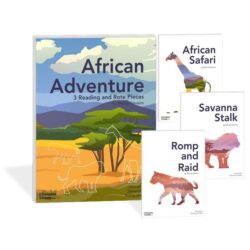
African Adventure Bundle: Romp and Raid + Savanna Stalk + African Safari

Woodland Fun Bundle

Spotify is currently not available in your country.
Follow us online to find out when we launch., spotify gives you instant access to millions of songs – from old favorites to the latest hits. just hit play to stream anything you like..

Listen everywhere
Spotify works on your computer, mobile, tablet and TV.

Unlimited, ad-free music
No ads. No interruptions. Just music.

Download music & listen offline
Keep playing, even when you don't have a connection.

Premium sounds better
Get ready for incredible sound quality.
Piece Pointers – Piano Safari 1
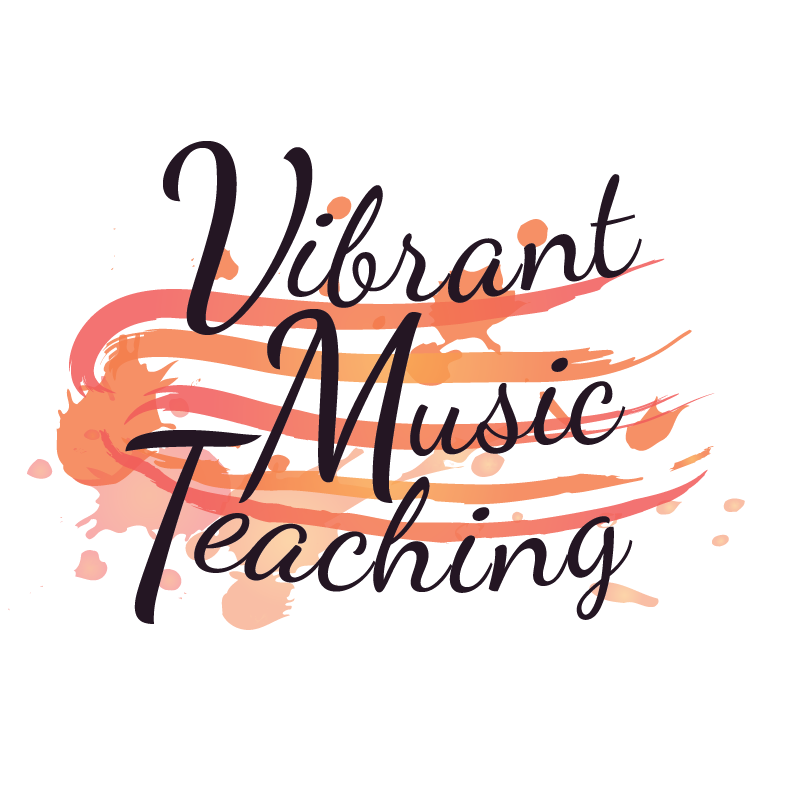
CDE March & FGAB Waltz
That page is for members only. If you're already a member you can login below.
Are you not a member yet? You're missing out! Click here to find out what's included in our membership and sign up today.
itsmyschoollibrary
Your lesson notes in a blink.
Literature in English
The Poem Piano And Drums By Gabriel Okara: A Complete Study Guide For WAEC, NECO, GCE, JAMB.
Welcome! Our literature lessons continues, do have a great moment studying with us!

Lesson Note
Subject : Literature In English Topic : Summary Analysis of the poem “Piano And Drum” by Gabriel Okara. Lesson Objectives: This lesson is aimed at helping learners understand the poem Piano And Drum”. So by the end of the lesson, the learners should be able to:
- In few sentences sa the author is;
- Identify and write about setting of the poem;
- Discuss the forms and meter of the poem;
- Identify and discuss the themes in the in the poem;
- Identify poetic devices used in the poem;
- Recite the poem “ piano and drums“.
Lesson Summary Aids: see reference materials below content.
Lesson Summary / Discussion
The very first time I heard of the poem piano and drums, I actually thought it was mere sound until I got a copy and read. After digesting the content, the expression of the poem deeply opened my mind and focused my thinking to African setting. And as an African, I could feel the pain of the poet having lost my identity to the western colonization in the name of civilization. This whole thing reminds me of an adage which says “you don’t know the value of what you have until you have lose it”. That is exactly the situation we Africans have found ourselves today. Though it is a good thing we are doing everything possible to retract our long footsteps but we can’t be sure until we get it back completely.
Below is an analysis of the poem Piano and Drums. Do have a wonderful time studying with is..
Meet The Poet
Gabriel Okara is one of the prominent African poets. He was born in 1921 and raised to be an Ijaw man at Bumadi village in Niger Delta, Nigeria. His full name is known as Gabriel Imomotimi Gbaingbain Okara.
As an African renowned poet, he is noted to be someone who fathoms African culture right from the onset. He is cognizant of the ways at which Africans are biding with their cultural orientation. In such case, he exerts an African musical instrument, drum that is peculiar to their primitive culture to make a stand for Africans and their culture in his poetic presentation. The drum is actually a symbol plied by the poet in order to make delineation for Africans.
Ordinarily, there are some other things or items that can still be stated as the Yoruba entity is taken as a case study to represent the whole Africa since Yoruba is one among enormous entities in the continent.
Primarily, drum is known as an instrument that its users sometimes use to carry on communication because drum as it is has its own language that can only be understood by learned individuals. Logically, drum normally is a musical instrument that provides beats to music. It provides rhythm to music and makes dancers perform to the tune.
Notwithstanding, drum is an instrument of communication that has its own language. Wole Soyinka and D. O Fagunwa in “The Forest of a Thousand Daemons” page seven say “like the sonorous proverb do we drum agidigbo (drum), it is the wise who dance to it, and the learned who understand its language.” This ratifies that the drum has its own language and the language can only be understood by people who had experience of how drum sounds.
Take for instance in some years dated back, there would be a set of drummers that would come to the king palace early in the morning to wake the king up with the drum. Once the drum sounded, the king would understand what his drummers were trying to orate with the drumming. That is drum at the stage of performing communication function.
Likewise among the drummers themselves, they used to communicate with one another with their drums especially when they did not want common people to get an earful of what they were telling one another let alone apprehending it. Yoruba used to say that “no one knows what drum is saying exactly like the drummer”. This is given confirmation that drum as an item of African culture has a language that can be interpreted only by learned.
This is what Africans had been addicted with before the arrival of the western people who introduced their culture that included instrument among which piano was one. No one in Africa had piano until white men barged into Africa. That is why the poem personae employs the piano to represent western culture and used drum to assume the role of African culture. The effect of European cultures can be seen among African ways of life that include speaking, dressing and others. This is the apprehension of the poet Gabriel Okara as depicted in the poem “Piano and Drum”.
Therefore in the poem, the poet conducts comparison and contrast between the drum and piano that indirectly indicates comparison between African culture and western culture. He is showing how he is feeling about both cultures. That is to say, whatever he says about piano is indirectly referring to European culture brought to Africa. In other words, whatever he says about the drum is indirectly attributing to culture of Africans. He actually uses both to present conflict that exists between the two worlds.
One effect of Africa’s contact with Western European culture is that the cultural identity of the African has been seriously compromised. The apparent inability of the now-decolonized African to reconcile those cultural values and norms of his authentic African past with the new, foreign modes of life continues to form the subject matter of the works of many post-independence African writers.
Gabriel Okara is one such African writer.
In his poem, Piano and Drums , Gabriel Okara uses symbols, diction and imagery to effectively demonstrate the African’s sense of loss of his cultural identity.
Just as it is the case with much of post-colonial African poetry, the persona in Gabriel Okara’s Piano and Drums is caught between two fundamentally different ways of life – African and European.
The immediate effect is that the African finds himself in a cultural dilemma. Should he follow the new foreign culture and abandon his own or is there a way for him to create a form of synergy between the two?
This is the new African’s dilemma. He is in a state of confusion and has been struggling ever since to rediscover himself.
Subject Matter of Piano and Drums
Piano and drums expresses the feelings and thoughts of a man belonging to and living in a primitive society in contrast to that of the western society. The poet being an African himself, and having studied in a western society, the poem reflect the confusion in his emotions as well as the loss of self identity. the title of the poem itself piano and drums displays a sense of the similarity and contrast as the instruments are so unalike in terms of sophistication. Throughout the entire poem, the poet incorporate the instruments to further Express, true music, how the speaker is feeling. By using well-structured stanzas and poetic devices such as imagery, symbolism, sensory detail, personification, diction etc, okara is able to immerse the readers into the difficulties of cultural conflict and the confusion of a person in the midst of the two contrasting societies. The poem is divided into four stanzas. The first two stanzas represent the “drum” culture; The second two stanzas show the “piano” culture.
Piano and Drums: Stanza One
In the first stanza of Piano and Drums , the persona speaks of finding himself at dawn deep inside an African jungle. He is specifically at a riverside. The sounds he begins to hear in this natural setting are authentic African rhythms coming from traditional African drums.
I hear jungle drums telegraphing the mysitic rhythm, urgent, raw like bleeding flesh, speaking of primal youth and the beginning
These sounds remind him of the original way of life of the African before the Europeans brought their culture to the continent.
The persona also sees wild animals that inhabit the virgin forests of Africa:
I see the panther ready to pounce The leopard snarling about to leap And the hunters crouch with spears poised.
Piano and Drums: Stanza Two
The subject matter of stanza two of the poem, Piano and Drums, is a direct consequence of the persona’s experience just narrated in the first stanza. The persona’s encounter with the original natural environment of his homeland has had a somewhat magical effect on him.
He is transported way back to his roots. The freshness and simplicity of this now-forgotten African past is vividly portrayed in these lines.
at once I’m walking simple paths with no innovations, rugged, fashioned with the naked warmth of hurrying feet and groping hearts in green leaves and wild flowers pulsing
Here then is a long-gone African past. It is an African past untainted by any form of foreign influence. It is marked by purity and innocence. We can hear very loudly the persona’s longing for the return of this pre-colonial period.
Piano and Drums: Stanza Three
Therefore, it is with dismay that the poet realizes that his experience as described in stanza two is nothing more than a dream. In stanza three of Piano and Drums , the persona returns to the reality of the present time.
This is a period when the original African way of life has undergone radical transformation. This is not very pleasing to the persona. The present period is buffeted by European influences.
Then I hear a wailing piano solo speaking of complex ways in tear-furrowed concerto; of far away lands and new horizons with coaxing diminuendo, counterpoint crescendo …
These foreign influences are, at the very least, confusing and disconcerting at the same time.
Piano and Drums: Stanza Four
Unlike the first three stanzas, the fourth stanza of Gabriel Okara’s poem, Piano and Drums, is relatively short. Four lines in all. But it is a set of four powerful lines that aptly summarizes the present situation in which the African finds himself.
In fact, this fourth stanza of Piano and Drums ends the poem on a pessimistic note.
We can see that the persona is caught between the desire to go back to his original African roots and the trappings of the new modern way of life with all its innovations. Thus, he is left “wandering”, not knowing exactly what to do or the best choice to make.
And I lost in the morning mist of an age at a riverside keep wandering in the mystic rhythm of jungle drums and the concerto.
The persona speaks to us about his sense of loss. He is clearly being pulled on both sides; in two different directions – the lingering overtones of his glorious African past and the influences of a new foreign culture. He is clearly in a state of dilemma.
So the poem Piano and Drums ends on an inconclusive note. The cultural confusion of the present reality of Africa has not been resolved.
Important Themes in Piano and Drums
The following is a comprehensive list of the themes worth considering in Gabriel Okara’s Piano and Drums
- Piano and Drums treats the theme of the unending clash or conflict between African culture and European culture. This is the inevitable outcome of European contact and colonization of Africa for more than five centuries.
- The poem Piano and Drums also deliberates on the African’s loss of his original identity following his contact with foreign European way of life.
- Piano and drums treats the issue of modernity versus old ways of life.
- Another important theme in Piano and Drums is the need to preserve the positive aspects of African culture.
- The theme of the effects of western culture on African traditions is another way to look at the ideas expressed in Piano and Drums.
Let’s now turn our attention to the poet’s use of poetic devices to highlight the various themes in Piano and Drums .
Poetic Devices in Piano and Drums
- Diction and Imagery
Diction and imagery always move together. They are like two opposite sides of the same coin. One cannot function without the other.
In Piano and Drums , the poet employs specific words and expressions to evoke images that go to highlight the central theme of the clash between African tradition and European culture.
Just take a look at some important expressions that are used in the poem.
Imagery relating to the original African setting and its cultural heritage
This is effectively portrayed in the following expressions
- Riverside – visual imagery of the African natural environment
- Jungle, green leaves, wild flowers – Visual imagery of the African natural vegetation
- Mystic rhythm – Auditory imagery of the African cultural heritage
- Raw, naked warmth, rugged – Visual and gustatory and tactile imagery of the purity and innocence of the uncorrupted pre-colonial African way of life
- Primal youth, beginning, suckling, simple paths, no innovations, – This ties in with the predominant image of the original, uncontaminated African culture before the contact with Western culture.
- Panther, leopard – These combine to further evoke visual images of original African natural environment before the introduction of Western technology – What the poet refers to as “innovations”.
- Hunter, spears – occupational imagery evoking memories of the pre-colonial African way of life
- Pounce, snarling, leap, crouch, poise, ripples, turns torrent, walking, hurrying, groping, pulsing – these verbs are deliberately chosen to depict the vitality of the African past. The visual and auditory imagery in these action words go to emphasize the persona’s deep sense of attachment to his African roots.
All the above instances of diction and imagery have largely succeeded in highlighting the poet’s attitude to his cultural heritage. His attitude is one of deep attachment and nostalgia – a yearning for the return of the heyday of African traditional way of life.
Imagery relating to foreign European culture
Let’s now take a look at the poet’s use of diction and imagery to depict the introduction of Western civilization on the continent of Africa and its corrupting effect on the original African way of life.
- Far away lands, new horizons
- Wailing, tear-furrowed concerto – auditory imagery of a disruptive foreign culture
- Complex ways, coaxing diminuendo, counterpoint crescendo – It depicts the difficulty the persona faces as he tries to understand and assimilate the new way of life.
Other poetic devices and figures of speech in Piano and Drums
Gabriel Okara has employed two musical instruments as symbols of each of the cultures that he portrays in Piano and Drums .
This is not surprising at all since music and dance are universally considered as an integral part of a people’s cultural heritage.
This represents foreign or European culture. Piano is a symbol of modernity and technological innovation.
This stands for traditional African cultural practices. The use of the drum as a musical instrument in many cultures dates back to a period long before the piano was invented.
- Raw like bleeding flesh – the freshness and vitality of the African natural environment and its way of life are emphasized in this comparison
- The naked warmth of hurrying feet
In this powerful metaphor, we find the same positive aspects of Africa and its traditional way of life that the poet is at pains to portray throughout Piano and Drums.
Here are instances of the use of metaphor in Piano and Drums that evoke images of the state of cultural dilemma the persona now finds himself. As we have observed, this dilemma follows Africa’s encounter with a completely strange culture.
- Lost in the labyrinth of its complexities – the persona’s sense of loss and confusion is powerfully evoked in this metaphor.
- …It ends in the middle
Of a phrase at a daggerpoint
This is a continuation of the image of the sense of confusion and loss referred to early on.
Run-on lines
The fast-paced run-on lines in the first two stanzas of the poem Piano and Drums go to emphasize the persona’s idea of a very lively natural African environment before the continent’s contact with the Western world.
- Mystic rhythm
The poet’s repetition of “lost”, “mystic rhythm” and “concerto” goes to depict his deep sense of confusion having to deal with what appears to be two diametrically opposed ways of life at the same time.
The repetitive use of the first person singular pronoun “I” shows that not only does the poet consider the situation to be a public one. He also considers it to be a deeply personal issue.
Alliteration
- …Turns torrent
Topples the years …
The imaginary found here is one more pointer to the vitality of the African past.
THE POEM STRUCTURE
From the poem, it can be scrutinized that there are only four stanzas with 29 lines or verses in the poem. The first two stanzas have 16 lines together that make full description of the drum as the poet perceives it. In that, feature and peculiarities of African culture is portrayed. Whilst the other two stanzas with 13 lines describe piano and show how the poet personae perceives the culture of colonial masters. That shows the complexity and technicality of the culture.
The tone and mood atmosphere of the poem seems to be sad and displays that there is regret in the poet’s mind as a result of negligent side that Africans have turned to their culture.
Done studying?
Our previous lessons might interest you.
Summary Analysis Of Crossing The Bar By Alfred Tennyson
Summary Analysis Of The Pulley By George Herbert
Summary and complete study guide of lonely days by Bayo Adebowale
Summary Analysis Of The School Boy By William Blake
Summary and Analysis of Ambush by Gbemisola Adeoti
Summary and study guide on faceless by Amma Darko
Harvest of Corruption by Frank Ogbeche: A complete study guide
Othello by Shakespeare: plot summary, setting, themes,devices, characters and roles.
Summary Analysis of The Panic Of Growing Older by Lenrie Peters
Summary Analysis of The Native Son by Richard Wright
The Blood of A Stranger: summary and complete study guide
THE CASTLE OF OTRANTO BY HORACE WADPOLE
Summary And Analysis Of The Poem Vanity By Birago Diop.
Literary Terms Used In Prose
Introduction to Literature: definition, Genres, importance: Complete study guide.
WAEC syllabus for Literature in English 2020/2021
Resources “Okara, Gabriel 1921–|Encyclopedia.com” . http://www.encyclopedia.com . Retrieved 25 Janua ry 2020 .
“ the-piano-and-the-drums” litionaryblog.wordpress.com/2017/12/19/. Retrieved 25 June 2020.
Discover more from itsmyschoollibrary
Subscribe now to keep reading and get access to the full archive.
Type your email…
Continue reading
- Inside SMCM
- Tips & Tricks

- Academic Calendar
- Contact Directory
- H.C.L. Library
- Student Portal
Prof. King Receives National Humanities Center Fellowship

Julia King, professor of anthropology and the George B. and Willma Reeves Endowed Chair in the Liberal Arts, was recently named a National Humanities Center Fellow for the 2024-25 academic year. The fellowship will allow her to focus on her project, Land as Archive: An Indigenous Landscape History of the Rappahannock People of Tidewater Virginia.
“This is an incredible opportunity for which I am grateful to both the National Humanities Center and St. Mary's College for recognizing the importance of this project,” King said.
The National Humanities Center, the world’s only independent institute dedicated exclusively to advanced study in all areas of the humanities, announced the appointments in a news release earlier this month. King was among 31 leading scholars appointed. There were 492 applicants from institutions across the globe.
“This fellowship is an exceptionally rare honor, and speaks to the importance and impact of Julie’s scholarship,” said Katie Gantz, vice president for academic affairs and dean of faculty.
King said she has a “career's worth” of archaeological, documentary, architectural and oral history the Rappahannock Tribe has shared with her and St. Mary’s College students that she has struggled to find time to synthesize into a book for a broader audience.
“The compelling history of the Rappahannocks has gone under-appreciated for too long, and the fellowship at the NHC will provide the time and space to write this history with oversight from tribal members,” she said.
The NHC will award approximately $1.5 million in fellowship grants to enable the selected scholars to take leave from their normal academic duties and pursue research at the Center.
For more information on the NHC, and the 2024-2025 fellowship recipients, go to https://nationalhumanitiescenter.org/the-national-humanities-center-announces-2024-25-fellows/ .

Washington University announces 2025 Great Artists Series
Next season to feature Pahud, Hough, Gomyo, Bronfman, Brownlee and Võ
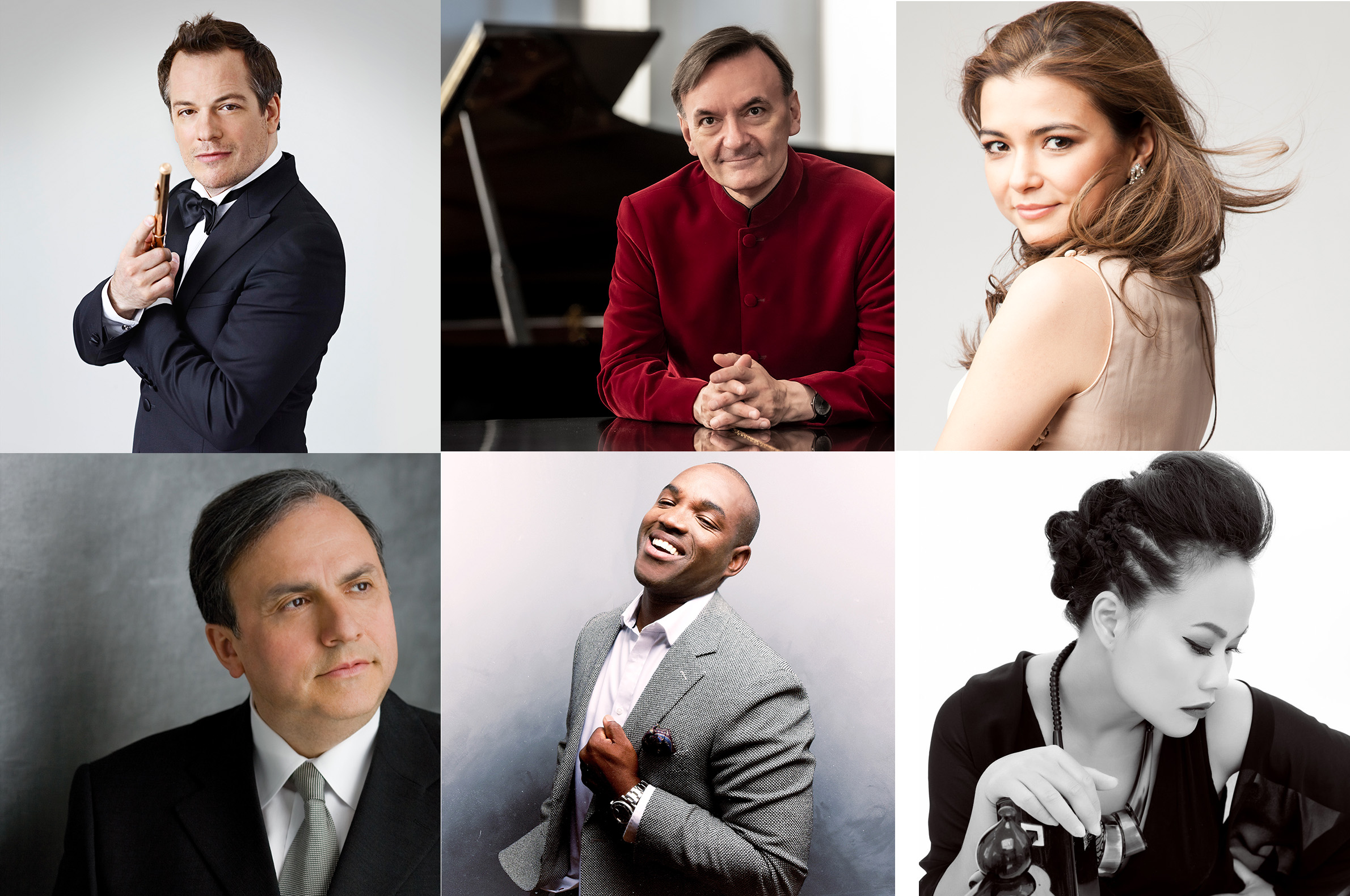
The Department of Music in Arts & Sciences at Washington University in St. Louis will host six performances by internationally renowned artists as part of the 2025 Great Artists Series.
Launched in 2017, the Great Artists Series presents intimate recitals featuring some of the brightest stars of the contemporary concert stage. All performances take place in WashU’s historic E. Desmond Lee Concert Hall, located in the 560 Music Center in University City.
The 2025 season will open Jan. 23 with Emmanuel Pahud, classical music’s reigning flute virtuoso, followed Feb. 2 by pianist and MacArthur “genius award” recipient Sir Stephen Hough. Celebrated violinist Karen Gomyo, accompanied by pianist Orion Weiss, will perform Feb. 16.
On March 2, the Great Artists Series will welcome the return of Grammy Award-winning pianist Yefim Bronfman, followed by star tenor Lawrence Brownlee March 23. Vân-Ánh Vanessa Võ & the Blood Moon Quartet, a chamber ensemble featuring traditional Vietnamese instruments, will conclude the series April 6.
“We’re thrilled to present another fantastic season of exciting music for WashU and the St. Louis community,” said Patrick Burke, a professor and chair of music. “Please join us next spring!”
Subscriptions to all six performances are $150 (a 38% savings on single ticket prices). Subscriptions include premier reserved seating, pre-concert talks with faculty experts and all ticketing fees. Subscription renewals will be available April 29 to May 31. New subscriptions go on sale June 4.
Single tickets are $40, or $37 for seniors and Washington University faculty and staff, and $15 for students and children. Single tickets go on sale Sept. 3.
The 560 Music Center is located at 560 Trinity Ave., at the intersection with Delmar Boulevard. Tickets are available through the Washington University Box Office, 314-935-6543.
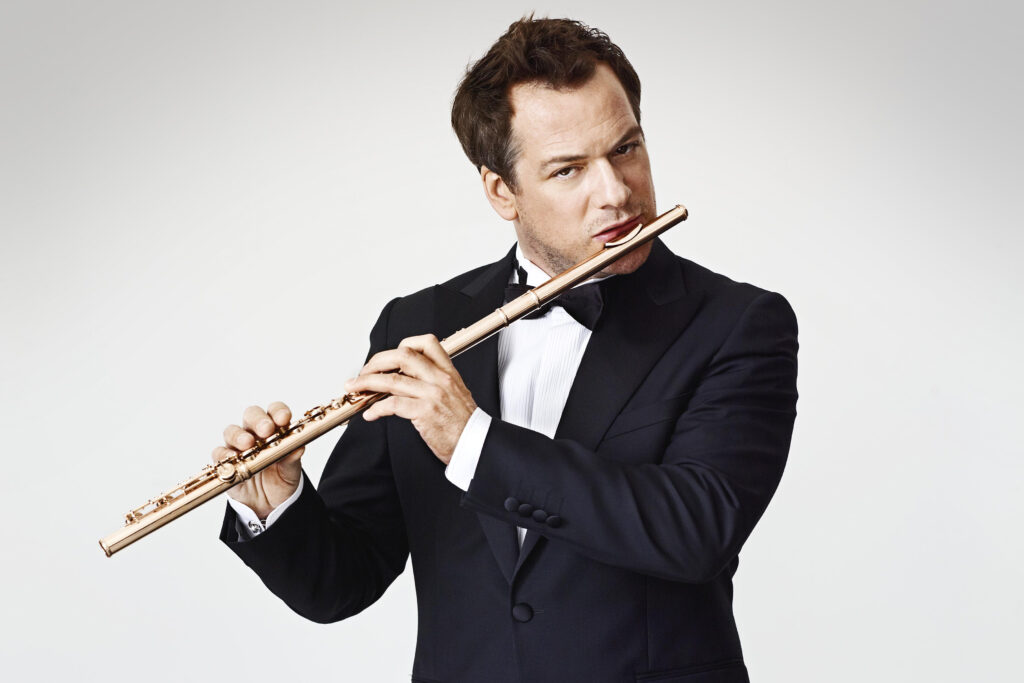
Emmanuel Pahud
“One of today’s most dazzling interpreters of the 20th-century flute repertoire” (BBC Music Magazine), Pahud won the National Competition of Belgium as a teenager, in 1985, and made his concert debut with the National Orchestra of Belgium later that year. He joined the Berlin Philharmonic Orchestra as principal flutist in 1992, after completing his training at the Conservatoire de Paris.
Pahud has appeared as soloist with many of the world’s top orchestras, including the London and Monte Carlo philharmonics; the NHK Symphony Orchestra; the Vienna Radio Symphony Orchestra; and the Orchestre philharmonique de Radio France. He made his Carnegie Hall debut as part of a U.S. tour with the Barcelona Symphony and Catalonia National Orchestra.
A dedicated chamber musician, Pahud co-founded the Le festival de l’Empéri in Salon-de-Provence, France. He has released 24 albums with EMI Classics — the only flutist in the world to have a solo recording contract with a major label — and made his jazz debut in 2003 with “Into the Blue,” a collaboration with pianist Jacky Terrasson. In 2009, Pahud was made a Chevalier dans l’Ordre des Arts et des Lettres by the French Ministry of Culture for his contribution to French music.
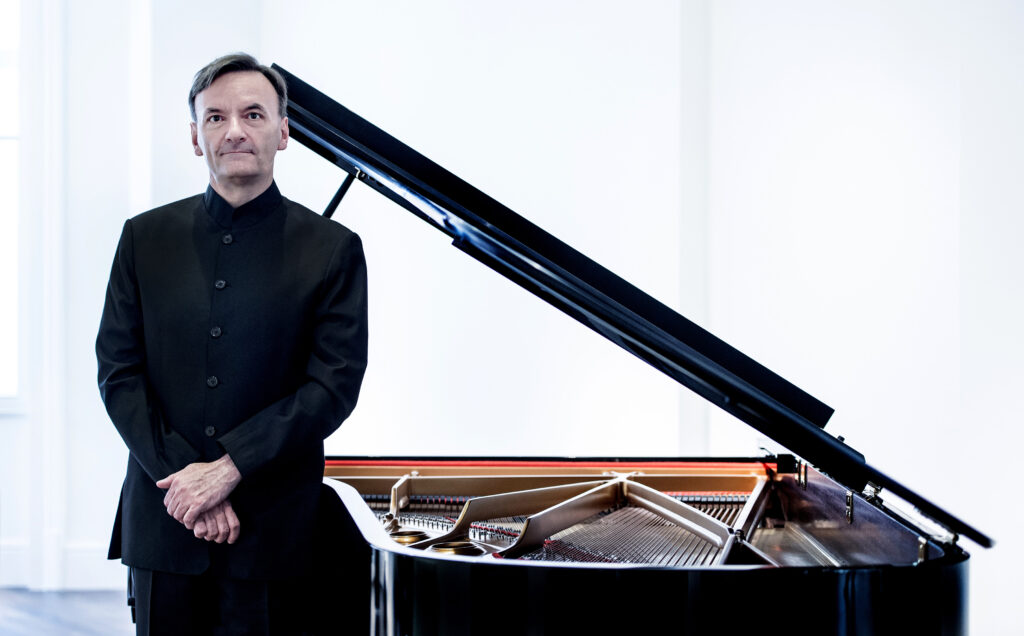
Stephen Hough
“A keyboard colossus” (The Guardian) with “uncannily subtle timing” (Gramophone), Hough was the first classical performer to be awarded a MacArthur fellowship.
Since taking first prize at the 1983 Naumburg Competition in New York, Hough has appeared with most of the major European, Asian and American orchestras and regularly plays recitals in major halls and concert series around the world. His many honors include Northwestern University’s Jean Gimbel Lane Prize in Piano and the Royal Philharmonic Society Instrumentalist Award. In 2014, he was made a Commander of the Order of the British Empire and in 2022 was knighted in the Queen’s Birthday Honours.
Hough’s catalogue of more than 60 albums has won the Deutsche Schallplattenpreis, Diapason d’Or and Monde de la Musique, among other international prizes, and received several Grammy nominations. He has won eight Gramophone Magazine Awards including “Record of the Year” in 1996 and 2003, and the Gramophone “Gold Disc” Award in 2008, which named his complete Saint-Saens Piano Concertos as the best recording of the past 30 years.
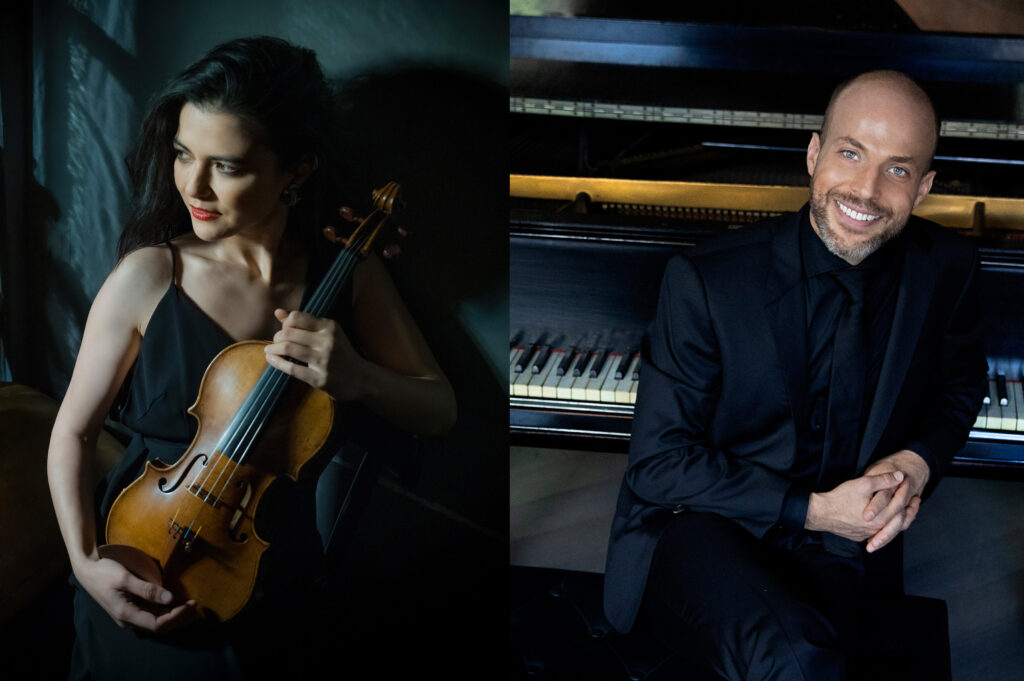
Karen Gomyo and Orion Weiss
“A first-rate artist of real musical command, vitality, brilliance and intensity” (Chicago Tribune), Gomyo has worked with the Cleveland and Philadelphia orchestras as well as the Chicago, San Francisco, Atlanta, Cincinnati, Houston, Vancouver, Indianapolis and Oregon symphonies, among others.
International credits include appearances with the Philharmonia in London, Danish National Symphony, Vienna Chamber Orchestra and the Hong Kong Philharmonic. She performed the world premiere of Samuel Adams’ Chamber Concerto and the U.S. premieres of Samy Moussa’s Violin Concerto “Adrano” and Matthias Pintscher’s Concerto No. 2 “Mar’eh.”
Weiss, a “brilliant pianist” (New York Times), is a sought-after soloist and chamber music collaborator, renowned for his “powerful technique and exceptional insight” (Washington Post). He has performed with dozens of orchestras across North America, including the Chicago and Boston symphonies and the Los Angeles and New York philharmonics.
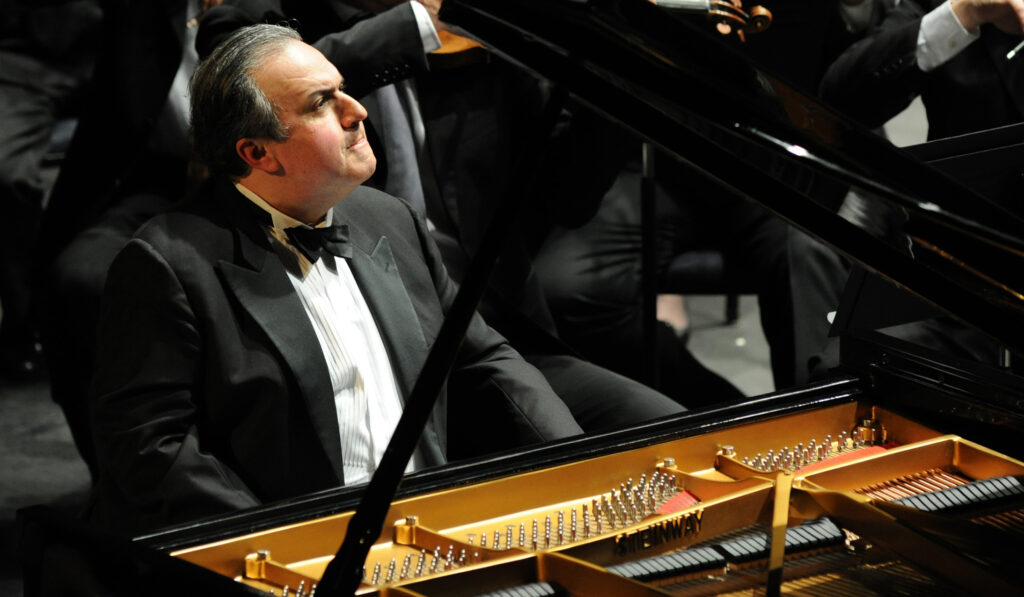
Yefim Bronfman
“A marvel of digital dexterity, warmly romantic sentiment, and jaw-dropping bravura” (Chicago Tribune), Bronfman is “a fearless pianist for whom no score is too demanding” (Wall Street Journal).
Renowned for his commanding technique and exceptional lyrical gifts, Bronfman has appeared with leading orchestras and given solo recitals in major halls around the world, including his acclaimed debuts at Carnegie Hall in 1989 and Avery Fisher Hall in 1993.
Widely praised for his prolific solo, chamber and orchestral recordings, Bronfman is a six-time Grammy nominee and winner, in 1997, for his recording of the three Bartók Piano Concerti, with Esa-Pekka Salonen and the Los Angeles Philharmonic. Other honors include the 1991 Avery Fisher Prize, one of the highest honors given to an American instrumentalist.
Bronfman previously performed for the Great Artists Series in 2017.
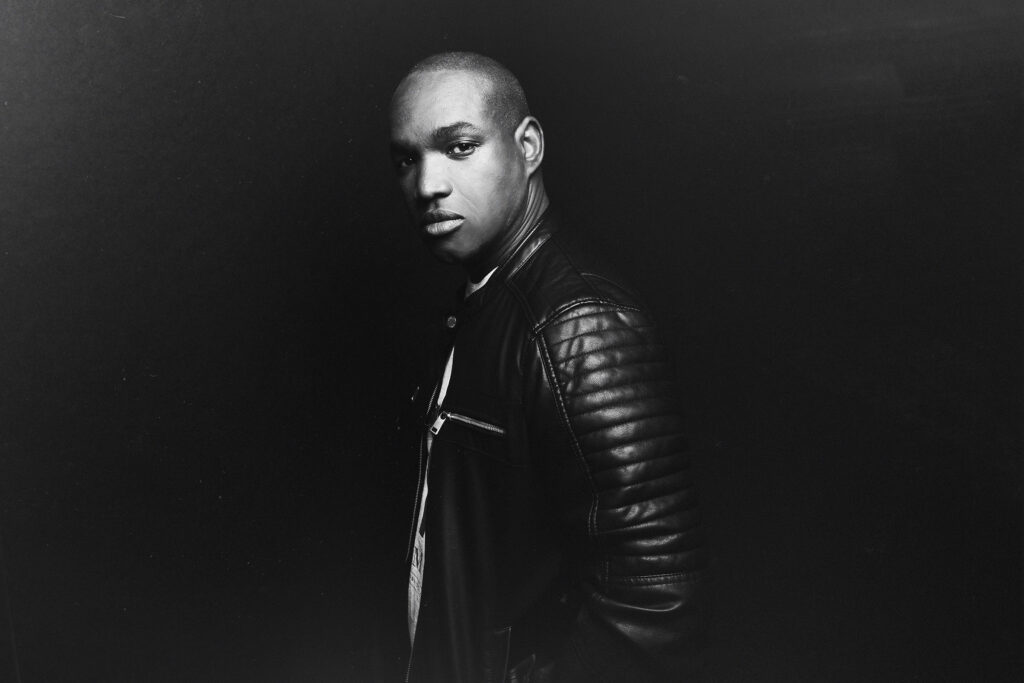
Lawrence Brownlee
“An international star in the bel canto operatic repertory” (New York Times), Brownlee is a leading figure in contemporary opera, both as a singer on the world’s top stages and as a voice for activism and diversity.
Brownlee has performed at many of the world’s most important opera houses, including the Metropolitan Opera, Teatro alla Scala and the Royal Opera House—Covent Garden. He has presented solo recitals at Carnegie Hall, Wigmore Hall and the Kennedy Center and has collaborated with, among many others, the Cleveland, Chicago and Philadelphia orchestras, Amsterdam’s Concertgebouw, and the festivals of Baden-Baden and Salzburg.
Currently artistic advisor for Opera Philadelphia, Brownlee learned to play bass, drums and piano at his family’s church in Hubbard, Ohio. His numerous honors include a grand prize in the 2001 Metropolitan Opera National Council auditions, Male Singer of the Year at the 2017 International Opera Awards, and the Kennedy Center’s Marian Anderson Award.
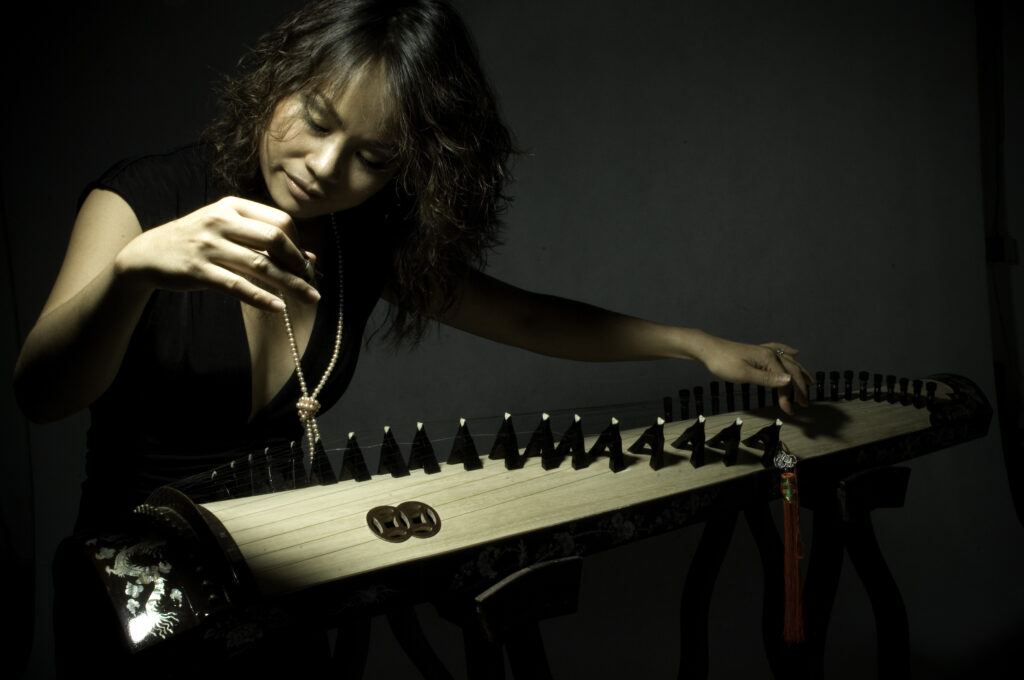
Vân-Ánh Vanessa Võ & the Blood Moon Quartet
Celebrated for her “rippling blend of musical genres” (San Francisco Classical Voice), Vân-Ánh Vanessa Võ is an Emmy Award-winning composer who has collaborated with Kronos Quartet, Alonzo King Lines Ballet and Yo-Yo Ma.
A virtuoso of the 16-string đàn tranh (zither), Võ also employs the monochord (đàn bầu), bamboo xylophone (đàn t’rung), traditional drums (trống) and many other instruments to blend traditional Vietnamese music with new structures, genres and compositions.
Võ founded Blood Moon Orchestra in 2016 as a collective of immigrant artists — including Japanese, Iranian, African-American, Turkish and Irish musicians — who are all composers, performers and educators. Their mission is to promote cultural understanding and respect while raising awareness about political and social issues and exploring the boundaries and capabilities of their respective instruments.
Comments and respectful dialogue are encouraged, but content will be moderated. Please, no personal attacks, obscenity or profanity, selling of commercial products, or endorsements of political candidates or positions. We reserve the right to remove any inappropriate comments. We also cannot address individual medical concerns or provide medical advice in this forum.
You Might Also Like

Latest from the Newsroom
Recent stories.
STL DataFest unites region’s data scientists
Kweskin to retire as executive vice chancellor for finance, chief financial officer
Field Notes: London Globe
WashU Experts
DeFake tool protects voice recordings from cybercriminals
Tremor a reminder that East Coast, Midwest earthquake threat is real
NASPA chair, WashU vice chancellor on the future of student affairs
WashU in the News
Alzheimer’s drug adoption in US slowed by doctors’ skepticism
As bird flu spreads in the U.S., is it safe to eat eggs? What to know about the risk.
Could the Union Victory at VW Set Off a Wave?

Home » Repertoire Book 1
Repertoire Book 1

Videos from 2008 and 2018 Editions are listed.
For additional video performances, subscribe to the Piano Safari YouTube Channel .
Introduction to the Animal Techniques Animal Techniques
A Day in the Life of a Tall Giraffe Reminder Video Performance Video Instructional Video
Alphabet Boogie Reminder Video Performance Video 1 Performance Video 2
Animal Improvisation Game Instructional Video
Autumn Performance Video
Bingo Performance Video
C D E March Reminder Video
Charlie Chipmunk Reminder Video Performance Video Instructional Video
Cleaver the Beaver Reminder Video Performance Video Instructional Video
Crocodile in the Nile Reminder Video Performance Video Instructional Video
Dandelion Fluff Reminder Video
Dragon Dance Reminder Video
F G A B Waltz Reminder Video
Hawk on the Mountain Peak Reminder Video
Hungry Herbie Hippo Reminder Video in Black Keys Reminder Video in C Reminder Video in B Reminder Video in F Reminder Video in G Performance Video
I Like Bananas Reminder Video Performance Video
I Love Coffee Performance Video Ensemble Reminder Video Part 1 Reminder Video Part 2 Reminder Video Part 3 Reminder Video Part 4 Reminder Video Part 5 Reminder Video Part 6
Kangaroo Reminder Video Performance Video Instructional Video
King of the African Drum Reminder Video Instructional Video
Kristabel Kangaroo Visits Korea Reminder Video Instructional Video
Lion Paw Reminder Video Instructional Video
Monkey Blues Reminder Video Performance Video Instructional Video
Monkey Swinging in a Tree Reminder Video Performance Video Instructional Video
My Dog Fritz Performance Video
Outer Space Reminder Video
Rainforest Mystery Reminder Video Instructional Video Instructional Video Second Half
Roaring Lion, Crouching Lion Reminder Video Performance Video Instructional Video
Robots Reminder Video
Skip to My Lou Reminder Video Performance Video
Soaring Bird Reminder Video
Swans on the Lake Reminder Video Performance Video
Talent Show Performance Video
Tall Giraffe Reminder Video Performance Video Instructional Video
Thunderstorm Over the Prairie Instructional Video
Tree Frog Reminder Video Performance Video Instructional Video
Twelve Bar Blues Improvisation Performance Video
Zebra on a Pogo Stick Reminder Video Performance Video Instructional Video
Zechariah Zebra Reminder Video Performance Video Instructional Video
Shop Home Login/Register
Search Piano Safari
Shop piano safari, currency switcher.

IMAGES
VIDEO
COMMENTS
Reminder Video for King of the African Drum, by Julie Knerr HagueRote Piece from:Piano Safari Level 1by Katherine Fisher & Dr. Julie Knerr Hague www.pianosaf...
Instructional Video for King of the African Drum by KnerrTaught by Dr. Julie KnerrRote Piece from:Piano Safari Level 1by Dr. Julie Knerr and Katherine Fisher...
Join my online piano course for kids at https://www.barfordpiano.com/Virtual-Piano-Prodigies King of the African Drum is a rote piece from Piano Safari Level...
In "King of the African Drum," we learn how to play like a grumpy, ferocious lion. Listen to her roar!
1. Lion - King of the African Drum Composition Principle: Form in Music. Compose a song sandwich for a different animal following the form; Sound Effect Intro + Melody + Sound Effect Ending; Be sure to choose a scale and pitch that represent the animal. Would a bird sound high or low? Is your hippo happy or sad (major or minor)? 2. Zebra ...
Piece Pointers - Piano Safari 1 Alphabet Boogie Charlie Chipmunk Hungry Herbie Hippo I Like Bananas Outer Space Ocean Animals & Tundra Animals ... Piano Safari 1 Lion Paw & King of the African Drum. Relevant resources: Piano Safari Level 1 book; Piano Safari member discount; Piano Safari Roadmap; Previous Lesson. Back to Course. Next Lesson ...
Piano Safari ® Repertoire Book 1 ... King of the African Drum Knerr Technique Rote Intro 32 Landmarks Musicianship 3 75 ... Piano Hand Shape Musicianship Intro 23 Ping Pong Knerr Reading 4 107 Posture Technique Intro 22 Rain Forest Mystery Knerr Technique Rote 3 97 Rhythm Musicianship Intro 17.
TITLE TYPE BOOK PAGE NUMBER TEACHER GUIDE PAGE NUMBER. Goals and Objectives 37 Sight Reading Cards Level A Reading 39 Black Keys Theory 23 40 Ocean Animals Reading 24 41 Tundra Animals Reading 25 43 Lion Paw Technique 26 44 Roaring Lion, Crouching Lion Improvisation 28 46 King of the African Drum Rote 30 47 Inchworm Reading 32 49 Sam Reading 33 ...
Animal Technique 1: Lion Paw. Lion Paw. Reminder Video. Instructional Video 1. Instructional Video 2. King of the African Drum. Reminder Video. Instructional Video. Roaring Lion, Crouching Lion.
Piano Safari -King of the African Drum (student)p.30Dr. João Paulo CasarottiCasarotti Online Piano Studiowww.jpcasarotti.com
54 views, 6 likes, 0 loves, 1 comments, 0 shares, Facebook Watch Videos from Pedal Notes Music Education: King of the African Drum is a real showpiece from #pianosafari Pattern pieces enable new...
Piano Safari member discount; Piano Safari Roadmap; Course Content Alphabet Boogie Charlie Chipmunk Hungry Herbie Hippo I Like Bananas Outer Space Ocean Animals & Tundra Animals Lion Paw & King of the African Drum Inchworm & Sam I Love Coffee Old MacDonald Had a Farm Fred the Fish Swans on the Lake CDE March & FGAB Waltz Mary Had a Little Lamb ...
PIANO SAFARI ® REPERTOIRE BOOK 1 ... 1 King of the African Drum Rote 30 1 Inchworm Reading Moderato 32 1 Sam Reading 33 1 I Love Coffee Rote 34 1 Old MacDonald Had a Farm Reading 38 1 Fred the Fish Reading glissando 40 1 Swans on the Lake Rote 42 2 White Keys Theory 43 2 C D E and F G A B Theory White Key Groups 44
African Safari. Rated 5.00 out of 5 based on 8 customer ratings. ( 8 customer reviews) $ 9.99. African Safari is one of the most popular pieces in the Rote and Reading™ series. African Safari - Reading and Rote Piano Piece. This comes with a studio license and is a fantastic value as this can be used for as many students as you directly teach.
About Press Copyright Contact us Creators Advertise Press Copyright Contact us Creators Advertise
39 views, 1 likes, 1 loves, 1 comments, 0 shares, Facebook Watch Videos from Melody's Piano Studio: We had a great performance class yesteday. This was her first ever performance! Congratulations!!...
Listen to King of the African Drum on Spotify. Katherine Fisher, Julie Knerr · Song · 2013. Katherine Fisher, Julie Knerr · Song · 2013. Listen to King of the African Drum on Spotify. Katherine Fisher, Julie Knerr · Song · 2013. Home; Search; Your Library. Create your first playlist It's easy, we'll help you. Create playlist ...
Lion Paw & King of the African Drum Inchworm & Sam I Love Coffee Old MacDonald Had a Farm Fred the Fish Swans on the Lake CDE March & FGAB Waltz Mary Had a Little Lamb ... Piece Pointers - Piano Safari 1 CDE March & FGAB Waltz. Relevant resources: Piano Safari Level 1 book; Piano Safari member discount; Piano Safari Roadmap; Previous Lesson ...
The poem Piano and Drums also deliberates on the African's loss of his original identity following his contact with foreign European way of life. Piano and drums treats the issue of modernity versus old ways of life. Another important theme in Piano and Drums is the need to preserve the positive aspects of African culture. The theme of the ...
Piano Safari Level 1 Repertoire Book: www.pianosafari.comStacey McDonald is a private piano teacher in Philadelphia, PA. She teaches children ages 4-18 at he...
Piano Safari ® Repertoire Book 1 ... Low 8 Intro Hot Cross Buns Rote Steady Beat 9 Intro Rhythm Musicianship 10 Intro Posture. Piano Hand Shape. Finger Numbers Technique 12 Intro Charlie Chipmunk Rote 15 Intro Hungry Herbie Hippo Rote 16 Intro Lion Paw Technique Arm Weight 18 Intro King of the African Drum Technique Rote 19 1 Black Keys ...
Julia King, professor of anthropology and the George B. and Willma Reeves Endowed Chair in the Liberal Arts, was recently named a National Humanities Center Fellow for the 2024-25 academic year. The fellowship will allow her to focus on her project, Land as Archive: An Indigenous Landscape History of the Rappahannock People of Tidewater Virginia.
About Press Copyright Contact us Creators Advertise Developers Terms Privacy Policy & Safety How YouTube works Test new features NFL Sunday Ticket Press Copyright ...
Currently artistic advisor for Opera Philadelphia, Brownlee learned to play bass, drums and piano at his family's church in Hubbard, Ohio. His numerous honors include a grand prize in the 2001 Metropolitan Opera National Council auditions, Male Singer of the Year at the 2017 International Opera Awards, and the Kennedy Center's Marian ...
Repertoire Book 1. Videos from 2008 and 2018 Editions are listed. For additional video performances, subscribe to the Piano Safari YouTube Channel. Introduction to the Animal Techniques. Animal Techniques. A Day in the Life of a Tall Giraffe. Reminder Video. Performance Video. Instructional Video.